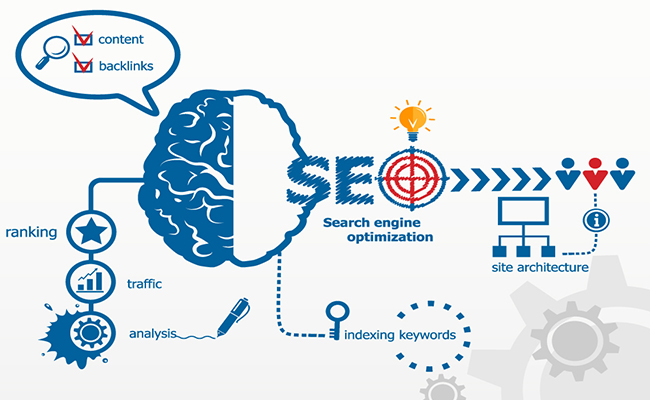Preface
In this article, we review Google’s RankBrain algorithm(the RankBrain Algorithm) and analyze the effects of this algorithm on the site and the RankBrain Algorithm with the machine learning algorithm.
In the past few weeks, there has been renewed enthusiasm for the Artificial Intelligence Optimization (AIO) debate, and many news sites and blogs have talked about it. We also intend to continue this process. In the past weeks, SEO experts’ attention to the impact of HTTPS on SEO and SEO is shifting towards RankBrain.
The fact of the matter is that artificial intelligence optimization seems to be a contradictory concept. If we imagine Google as a young child, when we send this kid to school and teach him to read a book, we expect him to understand the meaning of the sentences and the writing of the book as well. If the contents, information, and images of the book are not optimized, this child will not be able to learn and understand its contents.
Site optimization for the RankBrain algorithm is not a complicated thing. So why is there so much attention being paid to this issue, even if the algorithm is not new? In this article, we will review RankBrain and explain the previous concepts and analyze the effects of this algorithm on SEO.

What is RankBrain?
RankBrain is a machine-learning algorithm used by Google to convert large volumes of qualitative data into quantitative data and vectors so that it can be comprehended and analyzed by the computer.
15% of Google searches are searched for the first time per day, so it is common for this algorithm to see new searches. Using previously processed data, RankBrain can generate good results for new searches based on similar searches.
The percentage of new Google search terms has dropped from 25% in 2007 to 15% in 2017. But thanks to the rise of smartphones, the number of new searches has increased overall. Generally, RankBrain does the following:
- Interprets the search query
- Identifies the purpose of the search
- Selects results from the database

What is a machine learning algorithm?
Machine Learning algorithm is a computer science machine created by Arthur Samuel in 1959 and is described as follows:
[jv_quote style = “default” width = “0”] Machine learning algorithm gives computers the ability to learn without being programmed. [/ jv_quote]
Arthur Samuel founded early research in this area, including research on pattern recognition and computational learning theory.
The machine learning algorithm focuses on building algorithms that can predict based on statistical data and frequencies. Machine learning has been used in many applications before the RankBrain algorithm. These include spyware, network threats, intruder detection, and image character recognition. Although this science is part of artificial intelligence, it is not an advanced type and a high level one.

Learn the law of dependency
Association Rule Learning is a method of data mining in large databases that can be used to discover attractive relationships between existing variables.
Recently, this method has been used in online stores to detect the behavior of customers when shopping, producing discount coupons and training services. For example, a store can predict customers’ shopping behavior by collecting and analyzing its customer data.
The ARL method is also used to predict dependencies and relationships between variables. For example, if a customer buys cheese, onions, and onions in the store, he or she is likely to put the meat in his basket. The RankBrain algorithm uses such rules to provide search results, especially when different meanings of a word or phrase are picked.
An example of this is the English word, Dench. If a user searches for this word, three meanings are derived. Folklore is a brand of clothing or American actress Judi Dench, meanings that come from it. Due to the ambiguity of the meaning of this word, Google uses its algorithms and attempts to understand the user’s behavior while searching for the word, trying to understand the main purpose of the user and to display appropriate search results.
ARL concepts
The core concept of ARL is summarized in support, accuracy, progress, and development, but we use the concepts of support and trust in RankBrain.
Support
ARL support means measuring how an item is displayed in a database over some time. This concept varies with the search keyword density or the number of views they display.
Precision
Accuracy in ARL means measuring the accuracy of the prediction results of this algorithm. This function works based on interrelated vocabulary. For example, if a user searches for the word POTUS, which is abbreviated to US President, there is a high probability that Donald Trump will either search or see in the search results. We also see the names of Barack Obama, George W. Bush or Abraham Lincoln as their favorite search results.
Google’s RankBrain algorithm uses these dependency rules in its search results to show the most likely and most relevant items to the user.
RankBrain and SEO
The RankBrain project has been implemented in a variety of languages ranging from English to Hindi. The sole purpose of this algorithm is to help Google showcase the best in search terms so that the user gets the best user experience from Google and gets satisfactory results from their search.
The difference between Google’s work before and after RankBrain was launched was that before this algorithm emerged, Google software engineers had always modified their mathematical algorithms to determine the rank and position of sites when searching. This formula remains constant until an update is released. RankBrain is part of the core of Google’s search engine and has been in use since 2016. So with RankBrain, search results are constantly changing and sites are not stable.

Optimization and SEO for RankBrain algorithm
Now that we are familiar with the concept of RankBrain and have realized that this algorithm is working at the core of Google, we may need to change our SEO strategy. Especially sites whose SEO is an affiliate with backlinks. But RankBrain is not the same as Google’s former algorithms such as Panda and Penguin.
In the former Google algorithms, we knew how to avoid being penalized by the penguin algorithm, and by reading a series of articles we could keep the Panda algorithm happy. On the other side of the story, the RankBrain algorithm is a conceptual model that cannot be optimized for a website in a specific way. However, there are several SEO techniques that we know are associated with this algorithm.
Doorway Pages are no longer working
The idea of making a page focused on a particular keyword and building a large number of such pages called so-called Doorway Pages is completely obsolete. The Hummingbird algorithm identified these pages in 2103 and removed them from the results page. RankBrain also doubles the detection power of these pages so that they no longer have a chance to appear in search pages.
Using such keywords will only result in positive results when first used logically and secondly with appropriate URL content and structure. It also has a positive user experience for users.

Different searches have different ranking parameters
The RankBrain algorithm causes the ranking parameters to be the same for all words and queries and have different weight in each case. No more instructions can be used for each keyword and phrase.
Some terms require more content and fewer links, and others depend on less content and more links in the ranking. This account cannot complicate a fixed version of SEO for every phrase.
Internal link structure
Google’s official SEO guide states that an internal link to an article is effective in ranking it. Also, the content that is linked from the homepage is more valuable.
Therefore, optimizing the internal links of the site is one of the most important key factors for pages. Also, to increase the level of user experience, appropriate internal links between pages and content should be used.
What will the future of the RankBrain algorithm look like?
When the algorithm was launched in 2015, it initially only affected about 15% of search results. But a year later Google announced that the algorithm was highly developed and now affects almost all searches. This is probably the reason why many of the search results in 2016 have changed.
As the RankBrain algorithm becomes more powerful, we become more familiar with the concepts and relationships between the words and understand the relationship between the words searched for by the pages. This will also be very effective in the development of voice search, as well as in the accuracy of traditional searches.
conclusion
If you want to know what is RankBrain?In short, the RankBrain algorithm has been one of Google’s most important changes in recent years. Due to its concept and function, this algorithm cannot be optimized and SEO. But understanding it can make the site’s content more optimized and understand the changes and fluctuations in search results.
FAQ: the RankBrain algorithm
What is RankBrain?
RankBrain is Google’s name for a machine-learning artificial intelligence system that’s used to help process its search results, as was reported by Bloomberg and also confirmed to us by Google.
What is machine learning?
Machine learning is where a computer teaches itself how to do something, rather than being taught by humans or following detailed programming.
Is RankBrain the new way Google ranks search results?
No. RankBrain is part of Google’s overall search “algorithm,” a computer program that’s used to sort through the billions of pages it knows about and finds the ones deemed most relevant for particular queries.
What’s the name of Google’s search algorithm?
It’s called Hummingbird, as we reported in the past. For years, the overall algorithm didn’t have a formal name. But in the middle of 2013, Google overhauled that algorithm and gave it a name, Hummingbird.
So RankBrain is part of Google’s Hummingbird search algorithm?
That’s our understanding. Hummingbird is the overall search algorithm, just like a car has an overall engine in it. The engine itself may be made up of various parts, such as an oil filter, a fuel pump, a radiator and so on. In the same way, Hummingbird encompasses various parts, with RankBrain being one of the newest.
In particular, we know RankBrain is part of the overall Hummingbird algorithm because the Bloomberg article makes clear that RankBrain doesn’t handle all searches, as only the overall algorithm would.
Hummingbird also contains other parts with names familiar to those in the SEO space, such as Panda, Penguin, and Payday (the “Payday Update” was a new algorithm targeted at cleaning up search results for traditionally “spammy queries” such as [payday loan], pornographic and other heavily spammed queries.)designed to fight spam, Pigeon designed to improve local results, Top Heavy designed to demote ad-heavy pages, Mobile Friendly designed to reward mobile-friendly pages and Pirate designed to fight copyright infringement.
I thought the Google algorithm was called “PageRank”
PageRank is part of the overall Hummingbird algorithm that covers a specific way of giving pages credit based on the links from other pages pointing at them.
PageRank is special because it’s the first name that Google ever gave to one of the parts of its ranking algorithm, way back at the time the search engine began, in 1998.
What about these “signals” that Google uses for ranking?
Signals are things Google uses to help determine how to rank webpages. For example, it will read the words on a webpage, so words are a signal. If some words are in bold, that might be another signal that’s noted. The calculations used as part of PageRank give a page a PageRank score that’s used as a signal. If a page is noted as being mobile-friendly, that’s another signal that’s registered.
All these signals get processed by various parts within the Hummingbird algorithm to figure out which pages Google shows in response to various searches.
How many signals are there?
Google has fairly consistently spoken of having more than 200 major ranking signals that are evaluated that, in turn, might have up to 10,000 variations or sub-signals. It more typically just says “hundreds” of factors, as it did in yesterday’s Bloomberg article.

